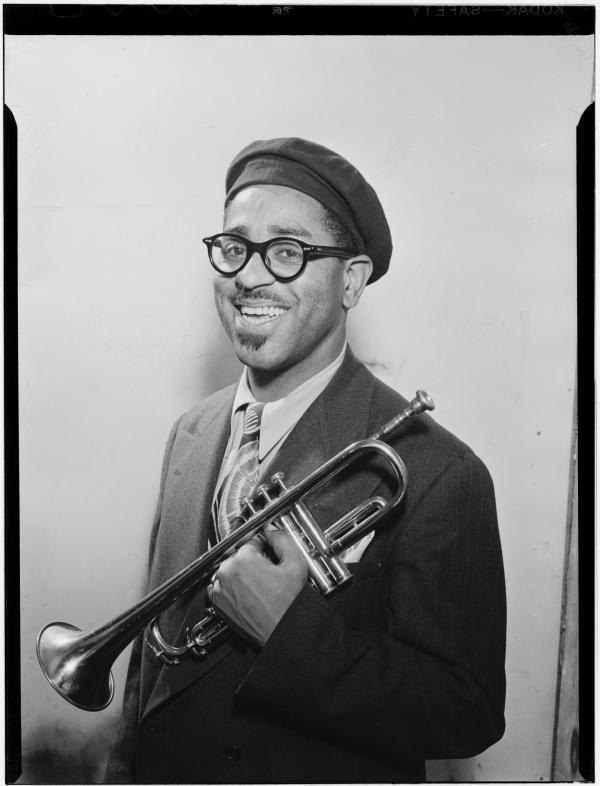John Birks "Dizzy" Gillespie

Photo by William P. Gottlieb/Ira and Leonore S. Gershwin Fund Collection, Music Division, Library of Congress
Bio
John Birks "Dizzy" Gillespie's effect on jazz cannot be overstated: his trumpet playing influenced every player who came after him, his compositions have become part of the jazz canon, and his bands have included some of the most significant names in the business. He was also, along with Charlie Parker, one of the major leaders of the bebop movement.
Gillespie's father was an amateur bandleader who, although dead by the time Gillespie was ten, had given his son some of his earliest grounding in music. Gillespie began playing trumpet at 14 after briefly trying the trombone, and his first formal musical training came at the Laurinburg Institute in North Carolina.
Gillespie's earliest professional jobs were with the Frankie Fairfax band, where he reportedly picked up the nickname Dizzy because of his outlandish antics. His earliest influence was Roy Eldridge, whom he later replaced in Teddy Hill's band. From 1939-41, Gillespie was one of the principal soloists in Cab Calloway's band, until he was dismissed for a notorious bandstand prank. While with Calloway he met the Cuban trumpeter Mario Bauza, from whom he gained a great interest in Afro-Cuban rhythms. At this time he also befriended Charlie Parker, with whom he would begin to develop some of the ideas behind bebop while sitting in at Minton's Playhouse in Harlem.
From 1941-43, Gillespie freelanced with a number of big bands, including that of Earl "Fatha" Hines. Hines' band contained several musicians Gillespie would interact with in the development of bebop, such as singer Billy Eckstine, who formed his own band featuring Gillespie on trumpet in 1944.
The year 1945 was crucial for both bebop and Gillespie. He recorded with Parker many of his small ensemble hits, such as "Salt Peanuts," and formed his own bebop big band. Despite economic woes, he was able to keep this band together for four years. His trumpet playing was at a peak, with rapid-fire attacks of notes and an amazing harmonic range. A number of future greats performed with Gillespie's big band, including saxophonists Gene Ammons, Yusef Lateef, Paul Gonsalves, Jimmy Heath, James Moody, and John Coltrane. The rhythm section of John Lewis, Milt Jackson, Kenny Clarke, and Ray Brown became the original Modern Jazz Quartet.
He took various bands on State Department tours around the world starting in 1956, the first time the U.S. government provided economic aid and recognition to jazz. Those excursions not only kept Gillespie working, they also stimulated his musical interests as he began incorporating different ethnic elements into his music, such as the Afro-Cuban rhythms he weaved into his big band arrangements. Never losing his thirst for collaboration, Gillespie worked with a variety of jazz stars as well as leading his own small groups on into the 1980s.
Selected Discography
The Complete RCA Victor Recordings 1937-1949, Bluebird, 1937-49
Dizzy's Diamonds, Verve, 1954-64
Birk's Works: Verve Big Band Sessions, Verve, 1956-57
Gillespiana/Carnegie Hall Concert, Verve, 1960-61
Max + Dizzy, Paris 1989, A&M, 1989

